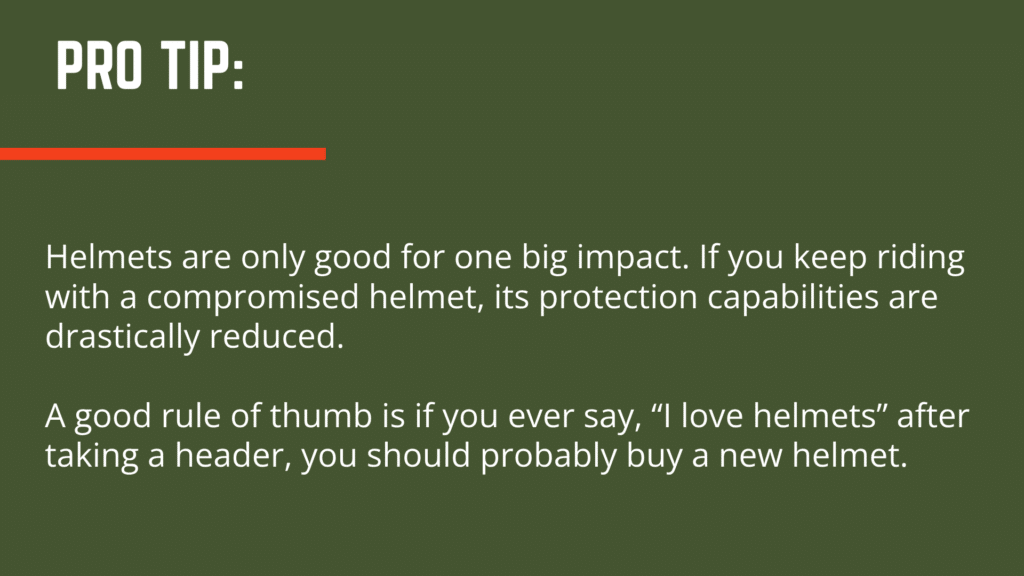It’s never a bad time to take inventory of your mountain biking gear. Things get worn out, misplaced, or outdated, and getting stuck out there with bunk equipment can ruin a great day. To make it easy for beginners and people without go-to equipment, we’ve curated a list of essential, nice-to-have, and worst-case scenario mountain biking accessories and equipment.
The gear that you need depends on the length of your ride, the quality of your bike, the frequency of maintenance, and experience. We know the list is long, but we tried to find everything you could ever need, and it put all in one spot. You definitely don’t need all items on this list, but if you ride with a group, you can all split carrying duty and make sure you’re covered for whatever happens on the trail.
Essential Mountain Biking Gear
Every rider should have most of these things for every ride. These items range from necessary safety equipment and emergency repairs to life-sustaining fuel. If you only read one section of this article, make sure it’s this one.
Mountain Biking Clothing
- Synthetic Shirt or MTB Jersey: Anybody who has worn cotton or linen on a hot summer day knows that once it’s wet, you’re in for a damp couple of hours. Synthetic materials like polyester or nylon are hydrophobic and wick moisture from your body.
- Mountain Bike Shoes: Aim for padded shoes with nonslip soles specifically designed for mountain biking. Five Ten is a rider favorite, but there are plenty of options to keep you sure-footed on your trusty steed.
- Padded Bike Shorts with Chamois Pad: While this essential isn’t technically essential, it’s still a nice-to-have and can help keep you comfortable during a long day of riding.
- MTB Shorts: Having a solid range of motion in your legs is important when you’re riding, and these options offer a perfect combination of comfort and breathability.
Essential Safety Gear
- Full-finger gloves: Your hands are usually the first thing to hit the ground after a bail, and riding with gashes on your hands isn’t fun. Plus, gloves eliminate sweaty palms messing with your grip.
- Eye Protection – A stray tree branch slapping your cornea at 30mph can do some damage. Sunglasses, goggles, or even safety glasses will work. Just make sure they’re secured.
- Helmet: The undisputed champion of safety gear. Whether you wear a full face or half shell, you should buy the helmet in person to try it on and see how it fits. Also, find one that uses Multi-directional Impact Protection System (MIPS) technology.

Repair and Maintenance Tools for Your Bike
- Flat Repair Kit: The kit mostly depends on whether you are running tubeless or not, but everyone will need a pump or CO2 inflator. Even tubeless riders should carry a spare tube as a failsafe. A ruined spare takes a situation from bad to worse, so protect the tube from punctures during storage. Final considerations for the kit include a tire lever and, a puncture kit.
- Tool Kit: Mechanical mishaps happen. Be prepared with a compact multi-tool, a few zip ties, a chain tool, a master link, and a spare derailleur hanger. When considering how much to include, think about how much you’d like to walk your bike out.
Repair and Maintenance (for Your Body)
- Water Bottle: If your bike doesn’t have a bottle rack, get a hydration pack. Long sessions should have a hydration pack, regardless. Water bottles also make great carriers for duct tape. Just wrap a few strips around the width of your bottle, and you’ll be ready to MacGyver anything.
- First Aid Kit: The repair kit for your body is a lot easier than the repair kit for your bike. Just get some nonstick gauze, medical tape, alcohol wipes, and maybe a triangle bandage.
- Snacks & Electrolytes: Protein bars, bananas, whatever. Bring a few packets of electrolyte powder to mix in with your water.
Other Items to Consider
- Hydration pack: This list has a lot of stuff. You’ll need something to lug it all around, and a well-fitting hydration pack is the perfect solution.
- Navigation Tool: Don’t get lost. Use a paper map, GPS, or mobile app. Make sure to pick a method that doesn’t require a cell signal.
- Plastic Pressure Sprayer:
- Old Towel or Bedsheet: Put one in the car and one just inside of your front door. The trail can stay in your heart, but keep it out of your upholstery.
Worst Case Scenario
This is less about mountain biking and more about survival. Nobody ever expects to rough it after a day out, but accidents happen. If you’re out on a long trip, or even if it’s a short trip in a remote area, you need to be prepared for anything. The items below can generally be ignored, but they may literally save your life if you happen to need them.
- Water Purification Tabs: Buy them online or at an outdoor recreation store. They have about a five-year shelf life, so keep…tabs on when you last replaced them.
- Bike light: Time gets away from you when you’re riding. If you plan to end your day within an hour or two of sunset, you’ll want a source of light.
- Fire Starter: It’s unlikely that you’ll need to start a fire, but a lighter or waterproof matches will only take up a little space in a backpack.
- Pocketknife: Not much to say about this. It slices, it dices.
- Bear Spray: The backcountry isn’t tamed, and even though bear spray can be bulky, it’s a heck of a lot better than being mauled. Also works on big cats, coyotes, and slow hikers hogging the trail. *
*It feels like we shouldn’t have to say this, but don’t blast hikers with bear spray. It’ll probably get you arrested.
The Most Important Gear
Although it’s not something that you can buy (and technically isn’t gear) knowledge is the most important thing for every mountain biker to have. Knowing the type of terrain that your ride is suited for can mean the difference between a rad day on the trails and a bad day full of bails. It’s also crucial to know how to service your bike on the fly, and this website provides some useful info on repairs.
If you’re new to the sport, or if you’re a veteran and just love talking shop, Base Camp Cyclery is the perfect place for you. Every member of our staff is an MTB lifer, and we never pass up an opportunity to share our wisdom. With locations in Denver and Castle Rock, we’re proud to be the best local bike shop around. Colorado is an amazing place to ride, so stop in and let us help you discover what the trails have to offer.

